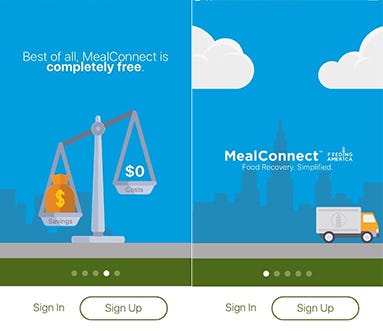Feeding America Adds Logistics to MealConnect Platform
The MealConnect platform allows small, local food businesses to donate their extra food within their communities.

Many families are preparing for the upcoming holiday season—a time for togetherness typically spent around the dinner table filled with food, drinks and holiday cheer. What many of these families do not realize is that about half of the fresh produce used to create that meal never made it to the table.
Feeding America is tackling the food waste issue by implementing programs utilizing technology to collect and distribute fresh, healthy food from coast-to-coast. In 2014, the Chicago-based hunger relief organization launched its MealConnect platform to allow small, local food businesses to donate their extra food in their communities.
“When a donor makes food available on MealConnect, an algorithm connects that donation with a local food pantry or soup kitchen, along with preferred pickup times, and then confirms back when a connection is made,” says Justin Block, director of retail information systems for Feeding America. “This all happens under the supervision of the local Feeding America food bank, so these meal-sized donations are handled with the same food safety expertise as the pallets and cases of perishable food our network has been managing for decades.”
Today, the platform has three main functions: MealConnect Core, MealConnect Real Time and the latest technology released this month, MealConnect Logistics.
MealConnect Core refers to the original, desktop platform that helps food banks track donations. MealConnect Real Time helps move donated food from the convenience of a phone. Both applications are free to use. MealConnect Real Time is local in nature and its availability is dependent on the local Feeding America food bank.
“We are currently in 14 cities and towns across the U.S. and should double that number by next summer,” says Block.

MealConnect Logistics is Feeding America’s new program with carriers on the road that grew out of a pilot with General Mills last year. Its national and “kicked loads” are connected daily across the country and have already facilitated the donation of more than 580,000 pounds of food to the Feeding America network of food banks in the pilot phase.
For the pilot, General Mills connected Feeding America with its carriers on the road. In complex supply chains, not every delivery to a grocery store, wholesaler or foodservice provider is flawless. Incorrect quantities or slightly damaged packages can result in a product that is commercially unsalable but perfectly safe to consume. When a trucker is on the road with surplus food, his carrier company can utilize MealConnect to find the nearest food bank and quickly reroute the driver to donate the surplus food.
“We believe that good business means finding every opportunity possible to help communities in our daily processes,” said Mary Jane (Melendez) Laird, executive director of the General Mills Foundation, in a statement. “In MealConnect Logistics, we see the perfect opportunity to partner Feeding America’s technology with our carriers and find a way to feed more hungry Americans.”
When a driver’s delivery is refused by the customer—could be the wrong quantity or some cosmetic damage—the driver radios back to dispatch. The dispatcher posts on MealConnect information about what the product is, where the driver is currently and where the driver’s next destination is.
The algorithm then locates the Feeding America food banks in the immediate area and, along the driver’s route, notifies each one sequentially of the opportunity. Once accepted, both the dispatch and driver receive a notification informing them where the donation should be dropped off.

“MealConnect Logistics is an extension of (the MealConnect Real Time) technology. The real time app connects a local donation requiring a pickup with a food pantry or soup kitchen that’s right-sized for that donation,” says Block. “The logistics feature connects a truckload of product with the nearest Feeding America food bank to be delivered en route.”
For this technology to work successfully, Feeding America relies heavily on strategic partnerships like the one with General Mills.
“Beyond generously supporting MealConnect’s development and scaling, they were also the inspiration for evolving the technology to include MealConnect Logistics,” says Block. “At the same time, having a web-based, algorithm-driven platform allows the Feeding America network to partner in new ways.”
According to Block, Feeding America will continue to grow the MealConnect technology as needed.
“Because technology is a strategic enabler, we continue to evolve MealConnect beyond small, local donations and large logistics loads,” he says. “We are working to incorporate a volunteer management module, so a food bank can easily manage a large corps of volunteer on-call drivers to pick up donations, as well as building out the smartphone app, so our network can go paperless and electronically log pickups from grocery store partners.”
About the Author(s)
You May Also Like


